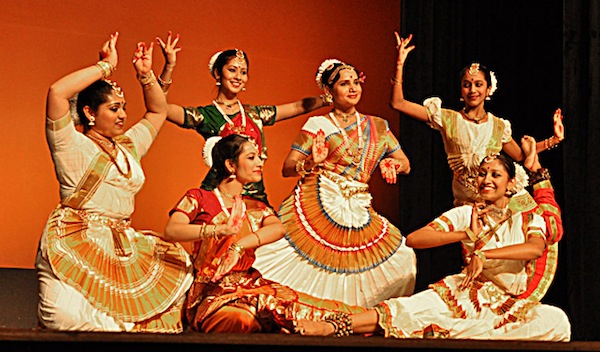
A not-so-traditional fairy tale: Sleeping Beauty meets Indian dance
By Jenna Buehler, Knight Foundation
Ranjana Warier calls herself a computer science and engineering geek with a passion for Indian dance tradition. As 2012 Knight Arts Challenge Miami winner, she is fusing her passions together to produce western fairy tales that demystify classic Indian culture. Warier, a cyber security expert by day, says her technical background blends well with this project. “In Indian dance, we use counts to do everything in set time measures. I also do all my music mixing myself because I’m comfortable using computers and software.” Her first thematic Indian production this fall will feature the classic fairy tale, Sleeping Beauty, mixing traditional dance and English narration. She says that the “experiment” has donors excited and that it helped launch the production sooner than expected.
In a Q&A with Knight Foundation, Warier takes us backstage for a preview.
A classic Indian dance arranged by Knight Arts Challenge winner, Ranjana Warier, is performed by Rythms School of Dance in Fort Lauderdale, South Florida
Why western fairy tales? How do these stories help to dispel common misconceptions about Indian traditions? RW: It helps to connects and engage audiences of all ages. The problem with traditional Indian dance is that we often lose people after the first 10 minutes. Abstract and obscure. There are symbols and complex codes. Not everyone has a background in Indian Mythology and if you don’t understand the meaning of what’s going on, it’s hard to be part of it and stay engaged. This dance drama puts customs into a story that people already know very well. Instead of just dancing and highlighting the differences, the thematic dances and English narrations will show the similarities. Ultimately, we try and educate the audience by engaging them and showing them something new.
Have you ever seen anything like this? What, if anything, inspires you? RW: I haven’t seen anything done like this with traditional Indian dance. The collaboration between George Harrison and Ravi Shankar has been an inspiration to me, since it brought a lot of exposure to Indian art form to western world. With our dance experiment we would like to highlight what Indian dance has to offer, by making it more approachable to people.
What fairy tale will you feature first? Have rehearsals started yet? RW: It’s Sleeping Beauty with a twist at the end. We have a script ready and are in the preliminary phase of choreography. Rehearsals will start in March. We’ll have six or so professional dancers and about 30 students that will need at least six years of previous indian classical dance training.
The younger generation is so excited about experiments like this in Indian classical dance. To them, the Indian tradition doesn’t feel like it connects with the mainstream. In tradition, it’s common to stay in the box and do the old stuff, do the stories that people cannot relate to. Kids get excited about the possibility to use same techniques to do something creative and innovative. Outside of rehearsals, we launching our lectureship series. We have some local interest, but we’re still looking for local libraries, museums, and schools that would like to be part of this conversation on demystification. For more information, they can contact me at [email protected].
You’ve received multiple grants for addressing cultural issues through dance. Why do you think people are investing in this type of art? What impact are we seeing in Miami? RW: I think that dance is an effective medium to communicate the message. In South Florida, people have interest because, like in India which has many countries within a country, South Florida is that same way. Both are a melting point of cultures coming together. People here relate to that a lot; people are recognizing a lot of things they haven’t been open to before because of the beautiful diverse opportunity here.
Recent Content
-
Artsarticle ·
-
Artsarticle ·
-
Artsarticle ·
